Dry-Brined Turkey
This post may contain affiliate links. Read my full disclosure policy.
Discover the secret to a perfectly juicy and flavor-packed bird with this easy dry-brined turkey recipe—it’s a holiday game-changer!
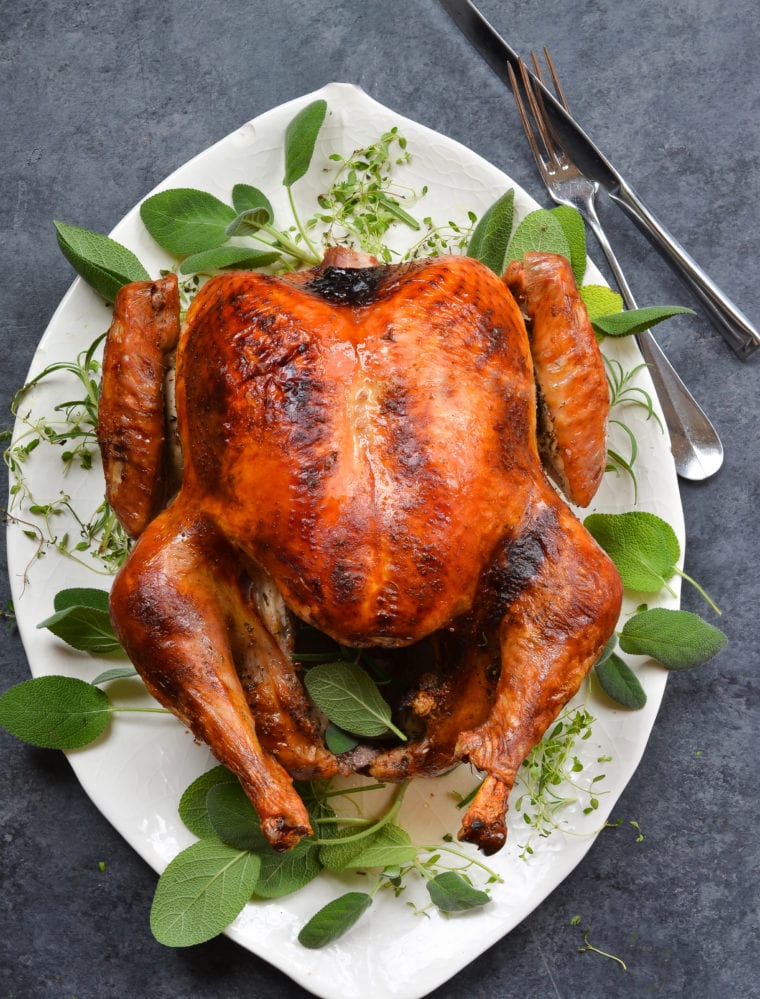
This fantastic dry-brined turkey, adapted from a Jeff Mauro recipe featured in Rachel Ray Magazine, was passed on to me by the talented food stylist Rebecca Jurkevich, who styled my second cookbook. What I particularly love about this recipe is its simplicity. You start by rubbing a mixture of salt and seasonings—the dry brine—onto the turkey’s skin, then let it rest in the fridge overnight. The salt not only thoroughly seasons the meat but also draws out the bird’s natural juices, creating a self-brine that the meat reabsorbs, guaranteeing a turkey that’s flavorful and juicy from the inside out. Plus, the rest in the fridge dries out the exterior of the bird, so when you cook it, you end up with the most beautifully crispy, golden-brown skin. Whether you’re a seasoned cook or a turkey first-timer, this dry-brined turkey recipe is a must-try for its ease and dependable results.
“My husband just declared this is the best turkey we’ve made in 40 years!!!! I concur!!”
What You’ll Need To Make A Dry-Brined Turkey
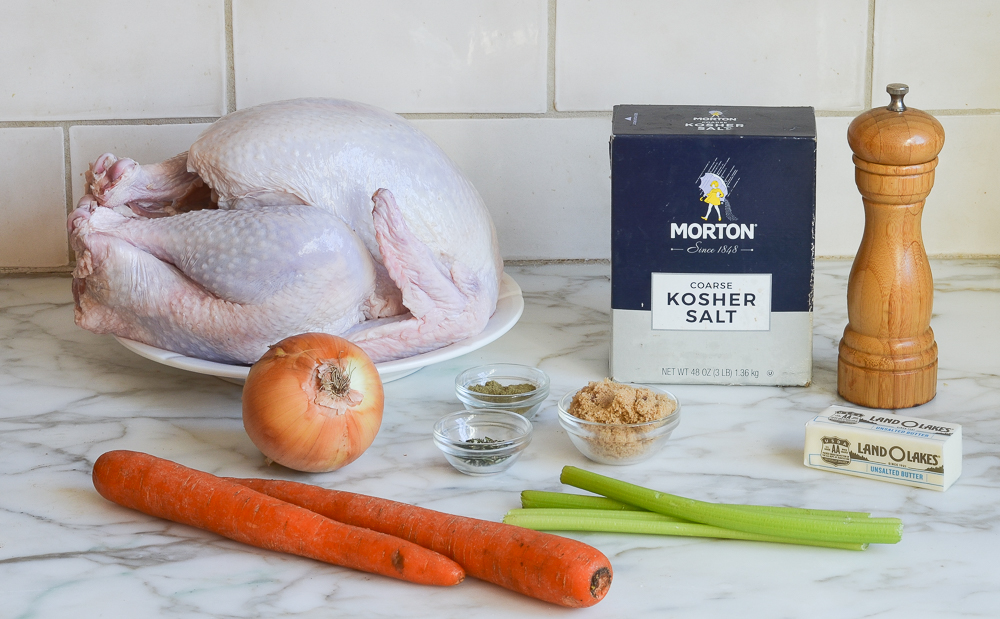
Step-by-Step Instructions
In a small bowl, mix the sugar, salt, thyme, sage, and pepper for the dry brine.
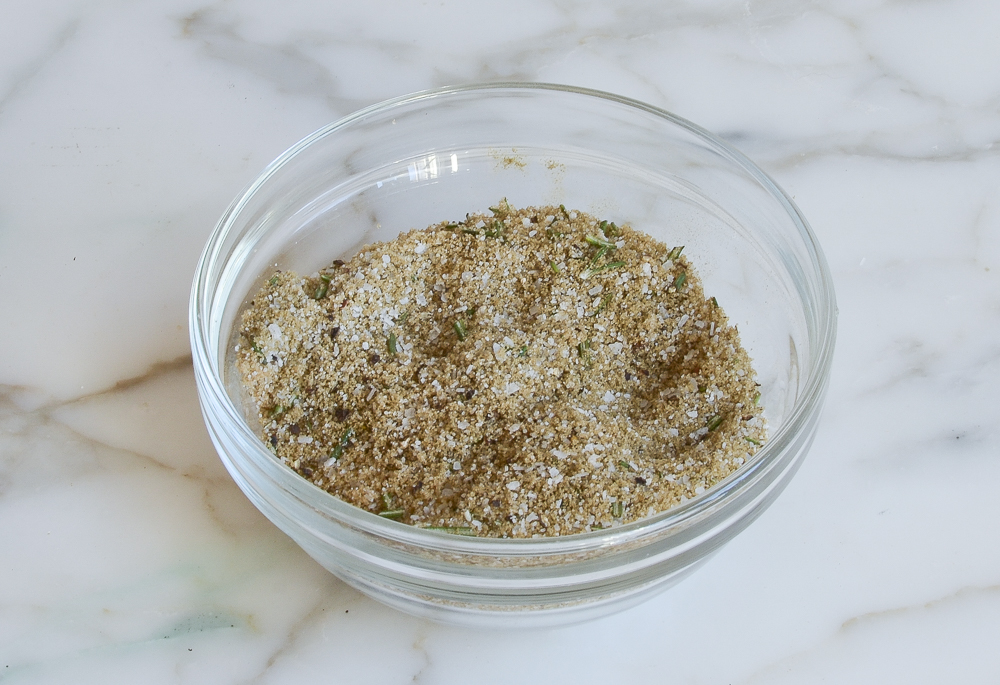
Place the turkey on the rack of a baking sheet. Rub and pat the dry brine all over the turkey, including inside the cavity. Refrigerate, uncovered, for at least 24 hours and up to 48 hours.
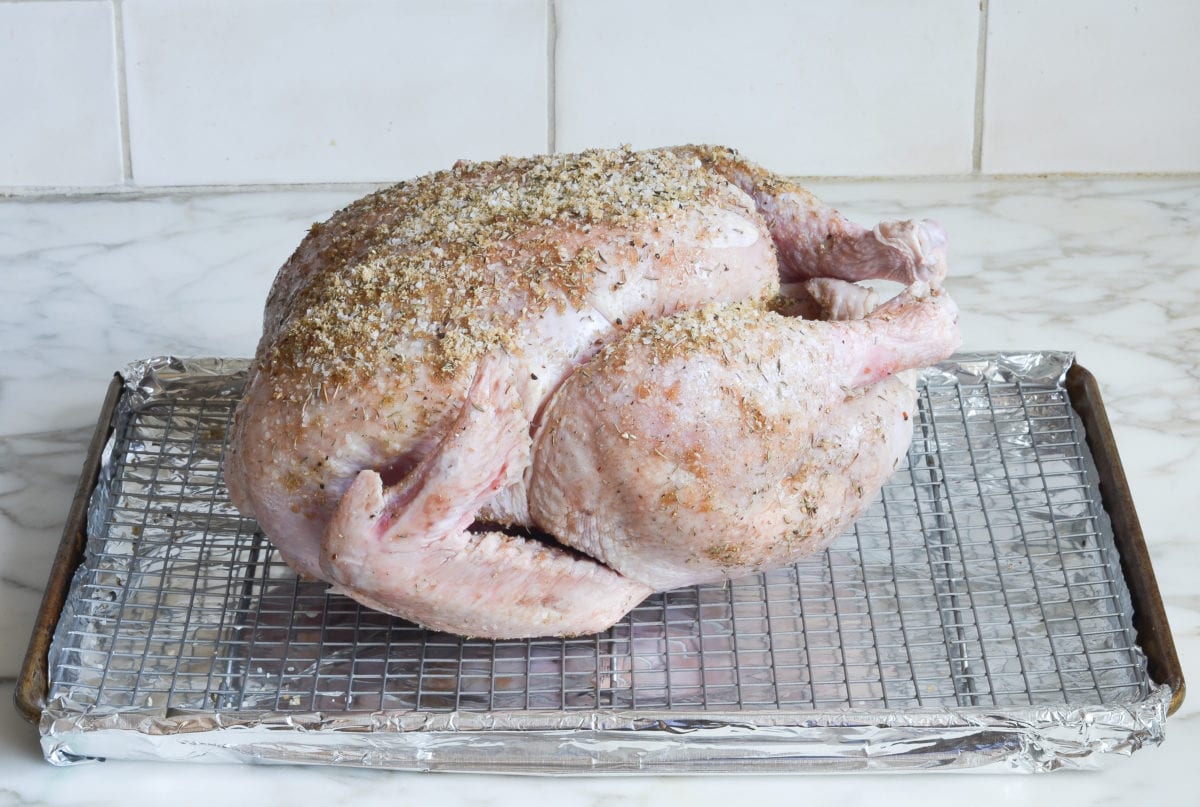
Using damp paper towels, brush the dry brine off the turkey.
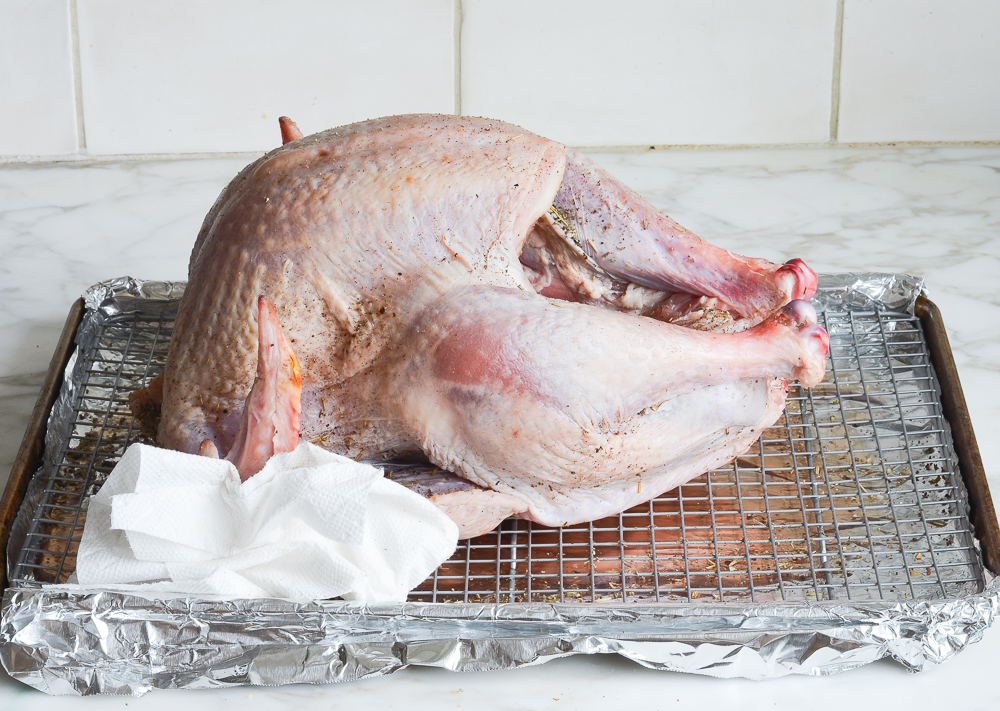
Scatter the onion, carrots, and celery in the bottom of a large roasting pan. Place a roasting rack inside the pan and place the turkey on the rack. Tuck the wings underneath the bird.
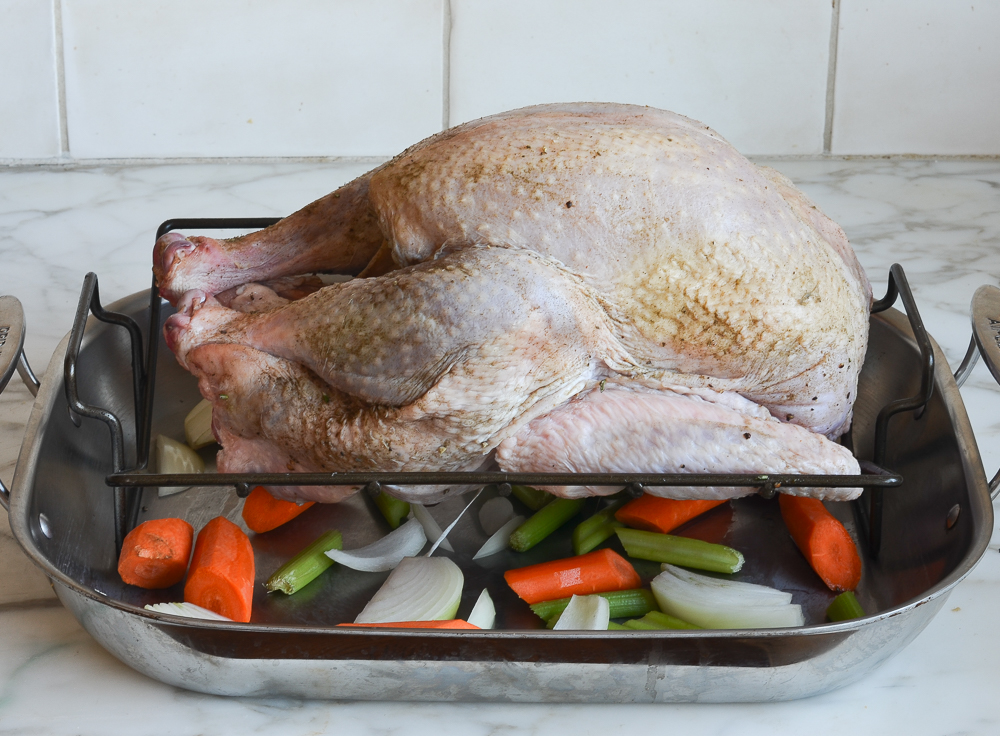
Using your hands, smear the butter all over the turkey.
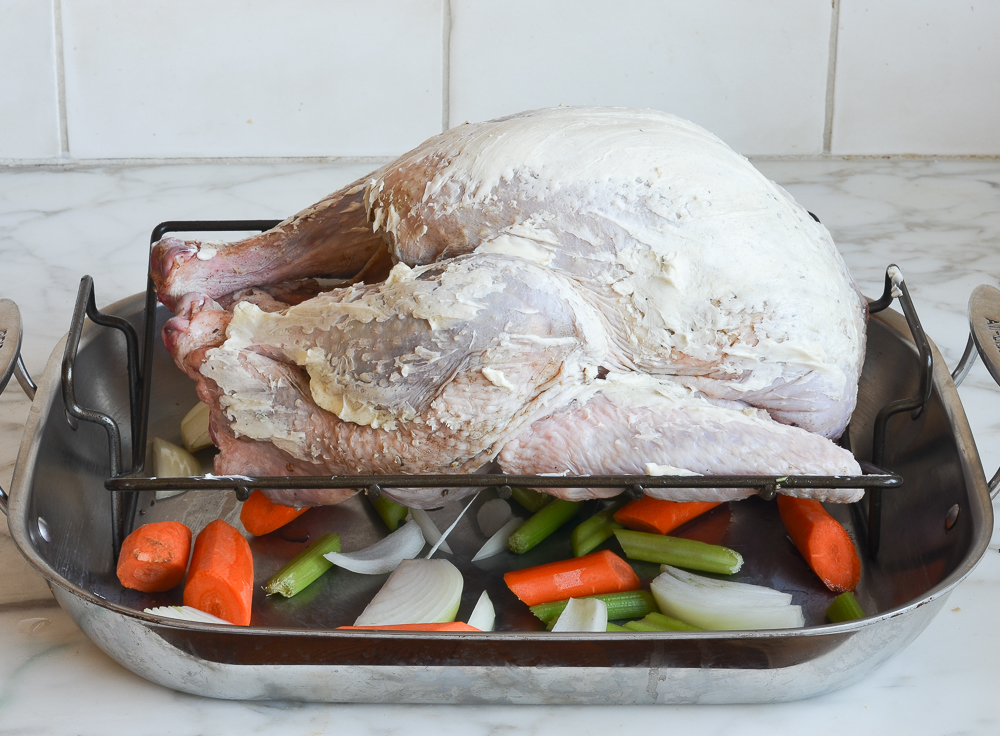
Roast the turkey until the skin is deep golden and an instant-read thermometer registers 165°F when inserted into the thickest part of the breast and the thigh, 1-3/4 to 2-1/2 hours. Check the turkey after 1-1/2 hours. If it’s getting too dark, cover it loosely with foil.
Note: The cooking time will depend on the size of your turkey. For best results, I recommend using a digital thermometer with a leave-in probe and remote monitor, like the one shown below. That way, you can monitor the temperature of the turkey without ever opening your oven.
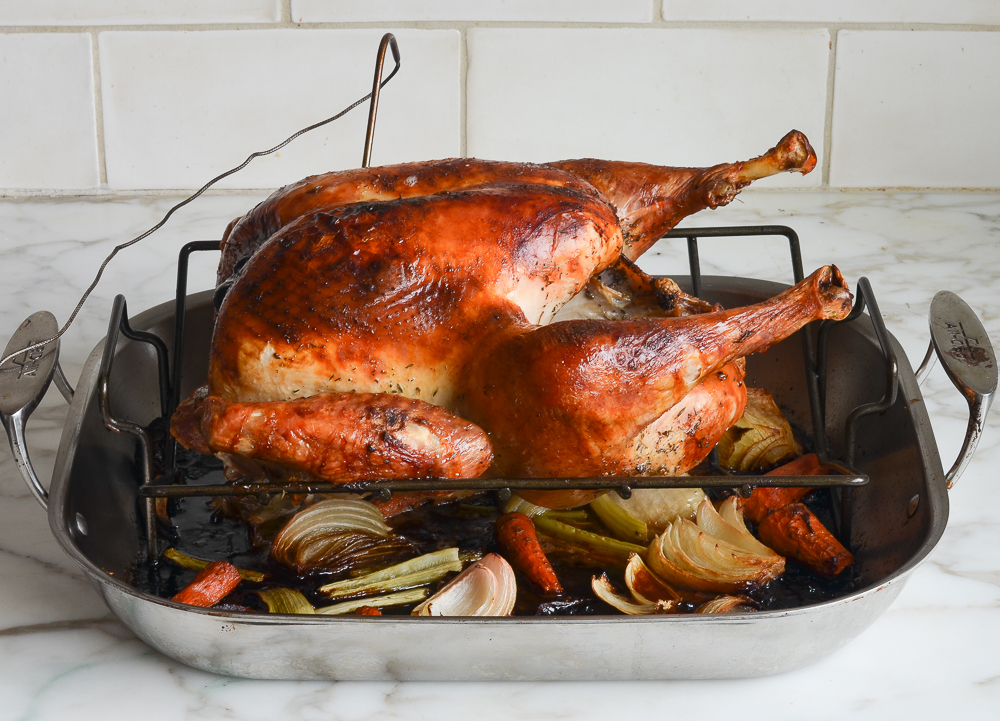
Using clean oven mitts (that you don’t mind getting dirty), carefully tilt the turkey so any juices from the cavity pour into the roasting pan. Transfer the turkey to a platter or cutting board. Tent with foil and let rest for 20 to 30 minutes. Remove the vegetables from the pan and discard (or if they aren’t too soft/brown, save them and arrange on the serving platter with the turkey). Reserve the drippings in the pan for the gravy. While the turkey rests, make the turkey gravy.
Carve the turkey and serve with the gravy on the side.
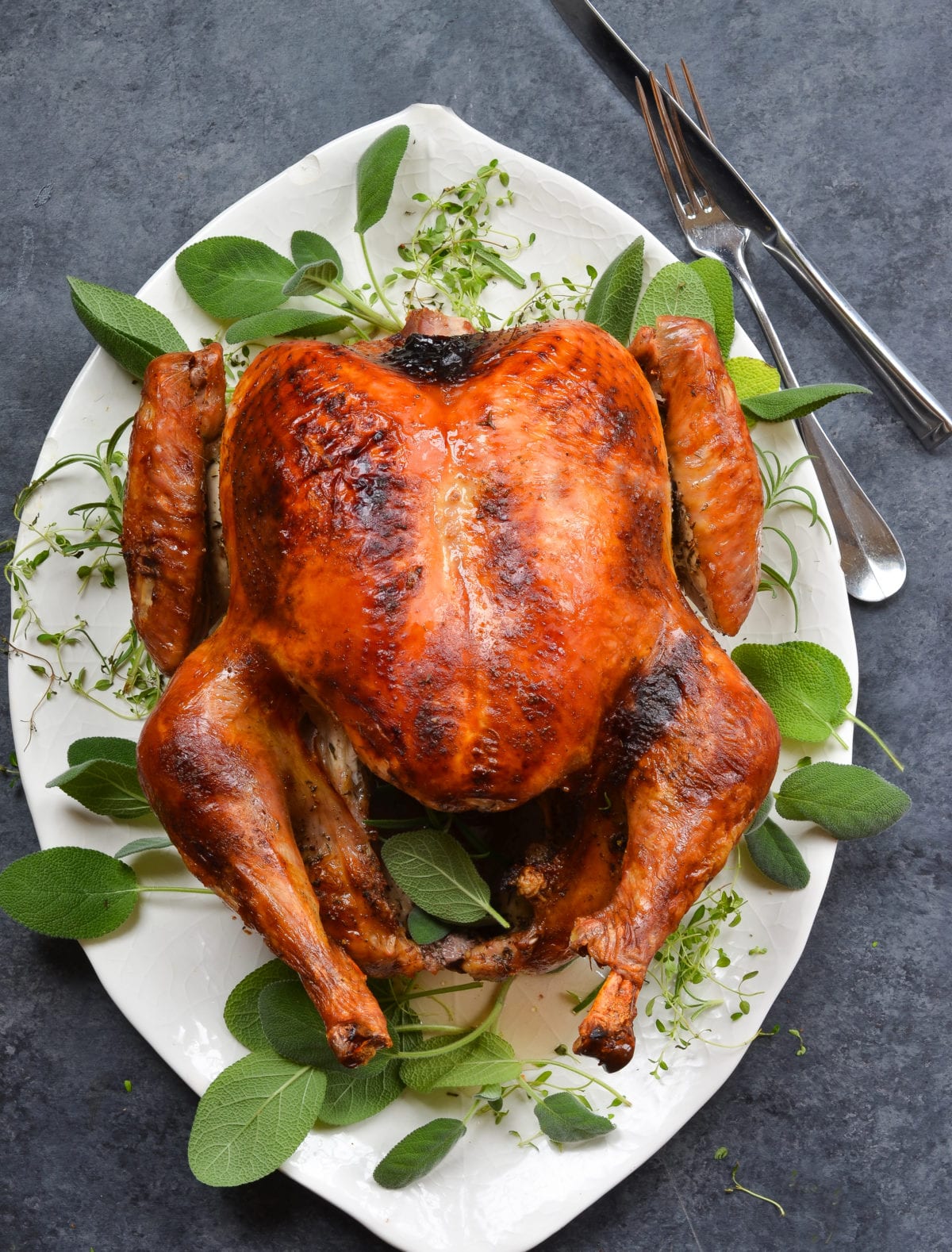
Frequently Asked Questions
A: Dry brining involves rubbing salt, herbs, and spices onto the turkey skin and letting it sit in the fridge overnight (or longer). Wet brining, in contrast, requires soaking the turkey in a seasoned saltwater solution, often necessitating a large cooler or bag and can be quite cumbersome. While both methods enhance flavor and juiciness, dry brining is much simpler and produces crisper skin.
A: The recommended time for dry brining is at least 1 day and up to 3 days. The longer you allow the turkey to brine, the more flavorful and moist it will be. However, even just 24 hours of brining can make a significant difference. You can adjust the salt quantity based on the brining duration to avoid over-salting.
A: If your turkey has been pre-injected with a solution (as is common with many store-bought turkeys), you can still use this dry-brined recipe effectively. These types of turkeys still benefit from additional seasoning for enhanced flavor. However, since they already contain some salt, you should reduce the amount of salt used in the dry brine by half to prevent the turkey from becoming overly salty.
You May Also Like
- 24 Best Thanksgiving Side Dishes
- 18 Thanksgiving Desserts Worth Saving Room For
- Rolled Turkey Breast with Sausage & Herb Stuffing
- Fresh Cranberry Sauce
- Creamy Make-Ahead Mashed Potatoes
- Easy Sausage & Herb Stuffing
Dry-Brined Turkey
Discover the secret to a perfectly juicy and flavor-packed bird with this easy dry-brined turkey recipe—it’s a holiday game-changer!
Ingredients
- 1 (12 to 14-pound) turkey, patted dry (see note)
- ¼ cup (packed) light brown sugar
- 3 tablespoons Morton kosher salt (or ¼ cup Diamond kosher salt)
- 2 teaspoons dried thyme
- 2 teaspoons dried sage leaves or ground sage
- 1 teaspoon freshly ground black pepper
- 6 tablespoons unsalted butter, at room temperature
- 1 large yellow onion, cut into wedges
- 2 carrots, cut into 2-inch pieces
- 2 stalks celery, cut into 2-inch pieces
Instructions
- Line a rimmed baking sheet with aluminum foil for easy clean up, and set an oven rack on top.
- Remove and discard the truss that holds turkey legs together (if the legs are held together with turkey skin, cut the skin to release them). Trim off and discard any excess fat in the neck or body cavity. Remove giblets and neck; discard or save for stock. Rinse the turkey inside and out with warm water. Pat dry with paper towels.
- In a small bowl, mix the sugar, salt, thyme, sage, and pepper for the dry brine. Place the turkey on the rack of the prepared baking sheet. Rub and pat the dry brine all over the turkey, including inside the cavity. Refrigerate, uncovered, for at least 24 hours and up to 48 hours. (For food safety, ensure the turkey remains in the refrigerator at 40°F or lower during the entire brining period. If brining for longer than 24 hours, you can cover the turkey loosely with plastic wrap for the first part of the brining process and then uncover it for the final 24 hours to allow the skin to dry.)
- Preheat the oven to 375°F and set an oven rack in the lower third of the oven. Using damp paper towels, brush the dry brine off the turkey.
- Scatter the onion, carrots, and celery in the bottom of a large roasting pan. Place a roasting rack inside the pan and place the turkey on the rack. Tuck the wings underneath the bird. Using your hands, smear the butter all over the turkey.
- Roast the turkey until the skin is deep golden and a leave-in or instant-read thermometer registers 165°F when inserted into the thickest part of the breast and the thigh, 1¾ to 2½ hours (see note). Check the turkey after 1½ hours. If the skin is getting too browned, cover it loosely with foil.
- Using clean oven mitts (that you don't mind getting dirty), carefully tilt the turkey so any juices from the cavity pour into the roasting pan. Transfer the turkey to a platter or cutting board. Tent with foil and let rest for 20 to 30 minutes. Remove the vegetables from the pan and discard (or if they aren't too soft/brown, save them and arrange on the serving platter with the turkey). Reserve the drippings in the pan for the gravy.
- While the turkey rests, make the gravy.
- Carve the turkey and serve with the gravy on the side.
- Make-Ahead Instructions: If you don't mind losing the crispy skin, the turkey can be roasted and carved ahead of time. Pour a thin layer of the gravy into an ovenproof serving dish. Arrange the carved turkey nicely on top of the gravy; cover tightly with plastic wrap and refrigerate for up to two days. Refrigerate the remaining gravy in a separate container. To reheat: remove the plastic wrap and cover the platter with aluminum foil. Place in a 325°F-oven for 20 to 30 minutes, until the turkey is hot. Reheat the gravy in the microwave or on the stovetop.
- Note on Selecting Your Turkey: For the best results with this dry-brining method, look for a turkey that is not kosher, injected, or labeled as "self-basting." These types of turkeys have already been treated with salt or a brining solution. However, if you can only find a kosher, injected, or self-basting turkey, you can still use this recipe, as these birds do still benefit from additional seasoning. Just halve the amount of salt in the dry brine to avoid over-salting.
- Note: I've given a range for the cooking time, which will depend on the size of your turkey. For best results, I recommend using a digital thermometer with a leave-in probe and remote monitor (like this one). That way, you can monitor the temperature of the turkey without ever opening your oven.
Pair with
Nutrition Information
Powered by ![]()
- Per serving (8 servings)
- Calories: 1,075
- Fat: 47 g
- Saturated fat: 15 g
- Carbohydrates: 6 g
- Sugar: 5 g
- Fiber: 0 g
- Protein: 147 g
- Sodium: 1,619 mg
- Cholesterol: 513 mg
This website is written and produced for informational purposes only. I am not a certified nutritionist and the nutritional data on this site has not been evaluated or approved by a nutritionist or the Food and Drug Administration. Nutritional information is offered as a courtesy and should not be construed as a guarantee. The data is calculated through an online nutritional calculator, Edamam.com. Although I do my best to provide accurate nutritional information, these figures should be considered estimates only. Varying factors such as product types or brands purchased, natural fluctuations in fresh produce, and the way ingredients are processed change the effective nutritional information in any given recipe. Furthermore, different online calculators provide different results depending on their own nutrition fact sources and algorithms. To obtain the most accurate nutritional information in a given recipe, you should calculate the nutritional information with the actual ingredients used in your recipe, using your preferred nutrition calculator.
Gluten-Free Adaptable Note
To the best of my knowledge, all of the ingredients used in this recipe are gluten-free or widely available in gluten-free versions. There is hidden gluten in many foods; if you're following a gluten-free diet or cooking for someone with gluten allergies, always read the labels of your ingredients to verify that they are gluten-free.

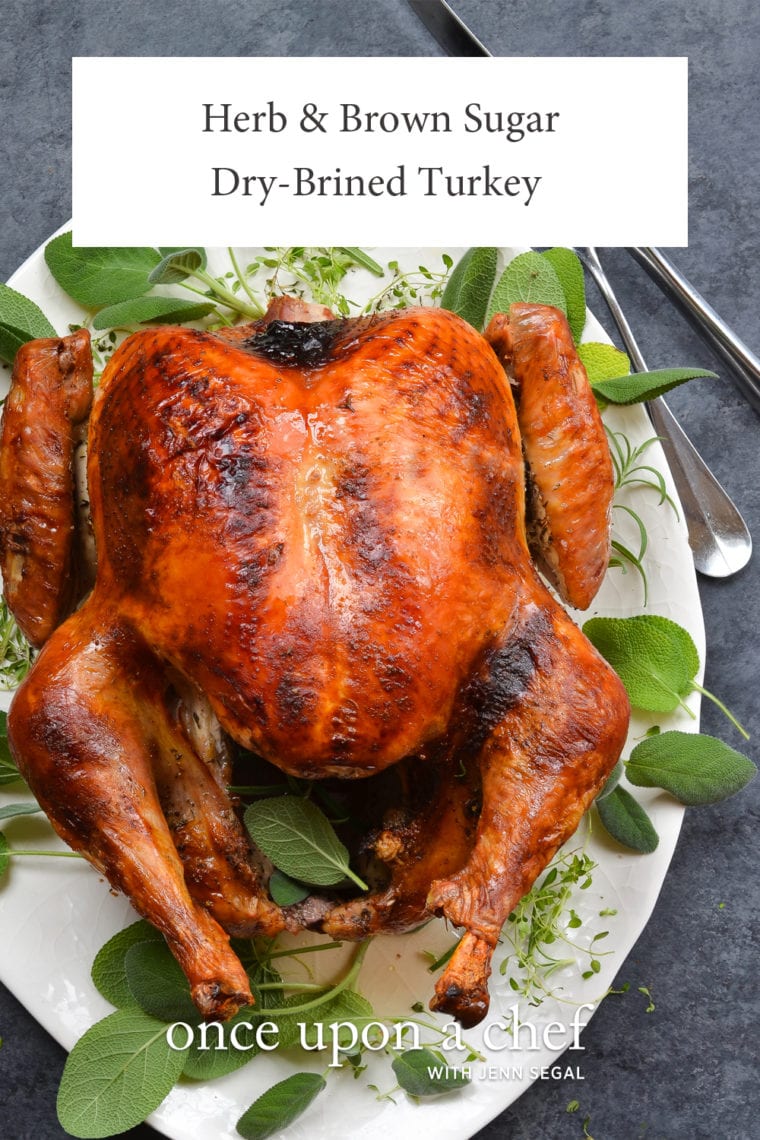
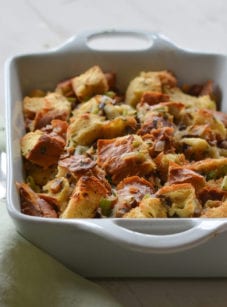
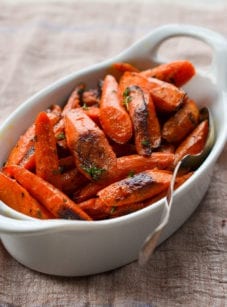
Made the dry brine turkey today and it was the best turkey I ever made. And I’ve been doing it for over 40 yrs. Decided not to stuff it. Really a better way to roast. The skin was crisp and beautiful and the turkey was perfectly done and juicy! (Used your recipe for stuffing which was great as well)!
I used this brine for the third year in a row and it continues to be a winner. This year I spatchcocked my turkey and it was outstanding. I highly recommend cooking it that way. All the meat, both dark and light came out moist and delicious and it cooked in 70% of the time it usually takes. Combined with Jenn’s dry brine, it was my best turkey ever. Happy Thanksgiving!
Did this for the first time for Thanksgiving 2023.
Brined it for 36 hours,
Wow,wow best turkey ever.
Very moist and perfectly seasoned.
Very easy to do.
Will use this brine from now on 👏👏👏
If I am just now seeing this recipe and don’t have a full 24 hours, is it still worth using this method?
Yep
Made it this year for Thanksgiving. Everyone enjoyed it, and not much left but bones. I did spatchcock it though.
Hi Jen! I dry brined my turkey yesterday and plan on roasting tomorrow, but I will not be serving this until Friday. I realize I will unfortunately lose the crispness of the skin by reheating, but do you have any tips on how to reheat this before serving? I’m worried it will be dry.
This is only the second time I’ve roasted a turkey, but your recipes are my go-to because they are fool proof! So many of my family’s favorite dishes come from your recipes. Thank you!
Hi Jessica, It should be just fine (in fact, I often make and carve my turkey ahead!). Simply our a thin layer of the gravy into an ovenproof serving platter. Arrange the carved turkey nicely on top of the gravy; cover tightly with plastic wrap and refrigerate for up to two days. Refrigerate the remaining gravy in a separate container. To reheat: remove the plastic wrap and cover the platter with aluminum foil. Place in a 325°F-oven for 20 to 30 minutes, until the turkey is hot. Reheat the gravy in the microwave or on the stovetop.
Wonderful! Thank you!
Hi Jenn! Thank you for all your wonderful recipes, I’ve been a loyal follower for years!!
A question about Kosher Salt – I live overseas and the brands you mention are not readily available in the grocery store (nor is anything labeled “Kosher Salt”). The most commonly available thing is iodized fine sea salt. Can this be substituted? If so, do I need to make any adjustments to the amounts. Thanks in advance!
Hi Katherine, You can definitely use fine sea salt here. I would reduce the amount to 1-1/2 tablespoons.
Hi Jenn, I have a 17.75lb turkey (packaged though so probably less once giblets are removed?). I’d love to try this recipe as your high heat one suggests a turkey less than 14lbs… My turkey is a butterball/premium young, and it says ‘contains up to 8% of a solution of water, salt, spicers and natural flavor’. Could I still make this? I was thinking of increasing all the ingredients by 1.5, eliminating the salt and roasting at 325. What are your thoughts?
Hi Stephanie, Yes, you can still make this and I’d increase the ingredients by 1.25 to 1.5. Instead of omitting the salt, I’d cut it in half and roast it in a 325°F oven. I’d count on 12-15 min per pound when cooking an unstuffed turkey, so for a that size turkey, I would start checking around 3.5 hours. Hope that helps!
Hi Jen, I’ve a same size/type of turkey that Stephanie Nicole mentioned above. I just brined the turkey with the increased in ingredients 1.5 including the salt. I’m now worried that the turkey will be too salty. What should I do to fix the problem? Thanks in advance!
Hi Tina, I honestly wouldn’t worry about it — it’s hard to over-salt a turkey — but you can just brine it for a bit less time if you’re concerned.
Hi Jenn, just wanted to thank you for your reply and tell you this came out fantastic! Best turkey I ever had, a keeper for sure!!
So glad to hear it came out well!
Hi Jen, thanks for the recipe! Is it safe to leave the turkey uncovered in the fridge with other items? Thank you!
Andrew
Hi Andrew, As long as your fridge is clean and cold, and you avoid contact/cross contamination with other food items, it should be fine. However, if the thought of having the uncovered turkey in your fridge for an extended period worries you, you can loosely cover the bird with plastic wrap or put it in a turkey brining bag. But I would definitely uncover it for at least the last 12 hours before cooking to dry out the skin.
My turkey was a frozen 16 lb butterball. I did the dry brine. Didn’t stuff it. 375 degrees done in 2 3/4 hrs.
Hi Jenn,
My turkey is less than ten pounds and when I remove the giblets, etc. will probably weigh around 9 lbs. I’m going to stuff the bird. Should I still roast at 375 and for how long?
Hi Marilyn, Yes I would still roast at 375, and I’m guessing with the stuffing the cook time will be about the same – but I would use a thermometer to be sure.
Hi Jen, We are celebrating Thanksgiving a week and a half late this year. I just bought a 20 lb fresh turkey and will have to freeze it for over a week since it won’t keep in the fridge long enough to be safe for our celebration. i anticipate defrosting the bird in the fridge for about 4 days (1 day per 5 lbs) and want to know if I need to wait til the bird is fully defrosted, or can I put the dry brine on the last day or two of the defrosting period? Or is it better to wait til fully defrosted and then let it dry brine for a day or two after thawed?
Love your recipes!!
Thanks,
Jennifer
Hi Jennifer, it’s fine to start brining the turkey as it’s thawing. Enjoy!
I am trying your dry brine method for the first time this year. I’ve noticed some dry brining recipes call for the turkey to be seasoned/brined and then wrapped tightly in cling wrap before refrigerating for the first day or two of brining followed by one final day in the refrigerator with the wrap removed. Is there any value in that method? I confess I’m nervous about an uncovered, exposed turkey in the fridge for days!
Hi Anna, if you’re brining the turkey for 48 hours, you can wrap it with plastic wrap for the first 24. I’d remove it after that though as you need to give the skin some time to dry out. Hope you enjoy!